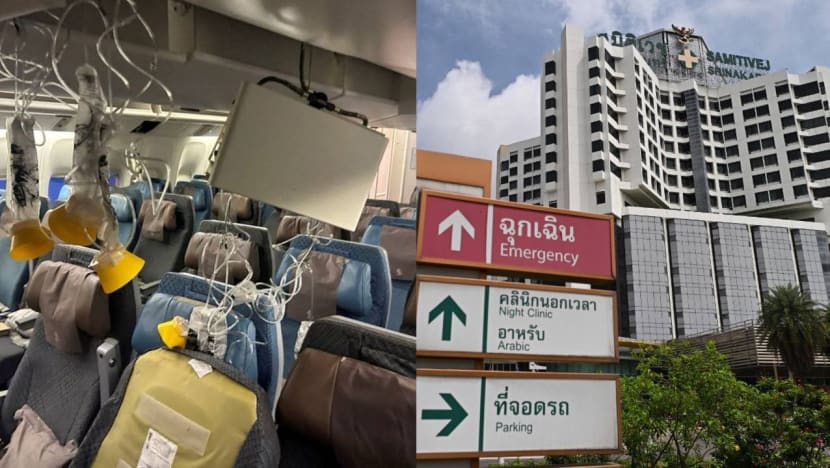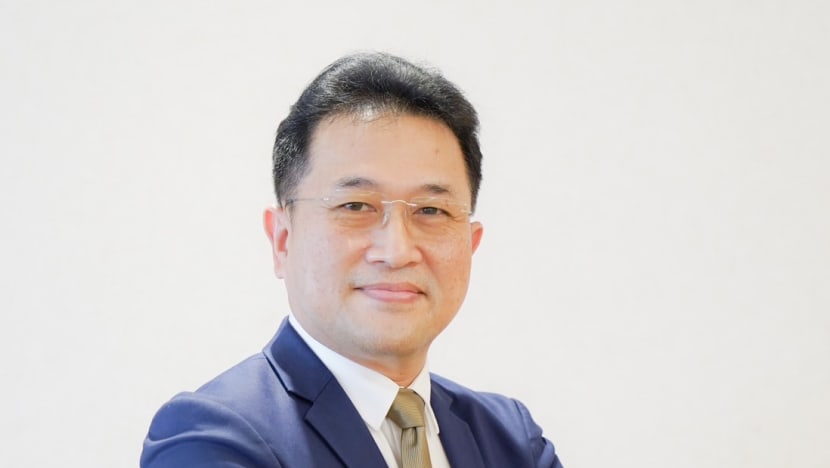'Can't move their body as usual': Some SQ321 passengers left Thailand in air ambulances, doctor says
Dr Saran Intakul said the passengers who are still warded in Samitivej Srinakarin Hospital are likely to be discharged within the next week or two.

The interior of Singapore Airlines flight SQ321 (left) after turbulence forced an emergency landing in Bangkokxy and (right) the exterior of Samitivej Srinakarin Hospital, where some injured passengers were being treated. (Photos: Reuters/Stringer, AFP/Manan Vatsyayana)

This audio is generated by an AI tool.
SINGAPORE: Two or three passengers who were on turbulence-hit Singapore Airlines flight SQ321 left Thailand in air ambulances, while others had nurses and doctors accompanying them on commercial flights.
Around 10 remain warded in Samitivej Srinakarin Hospital in Thailand more than two weeks after the incident, but most are fit to fly and are likely to be discharged in the coming weeks, the hospital's deputy director, Dr Saran Intakul, told CNA on Friday (Jun 7).
Dr Saran said the passengers who needed an air ambulance required further treatment or rehabilitation for the injuries sustained on the flight.
"They can't move their body as usual, so they need to have some escort to help them (travel) back home," he said.
Asked if these patients were experiencing paralysis, Dr Saran said "sort of that", but did not elaborate.
SQ321 was on its way from London to Singapore, and was over the Irrawaddy Basin in Myanmar when "rapid" G-force changes wreaked havoc in the cabin. Passengers and crew were thrown up to the ceiling of the plane before falling back down.
One British passenger, Mr Geoff Kitchen, 73, died on board, likely because of a heart attack, while others suffered brain and spinal cord injuries.
The day after the incident, 58 passengers were warded in three hospitals, including 20 patients in the ICU.
At that time, five Singaporeans from the flight, including two in ICU, were receiving treatment in Thailand.
CNA understands that Mr Bobby Chin, a former member of the Council of Presidential Advisers, was hospitalised in Bangkok, but is safely back in Singapore.
One patient, likely Singaporean, was still warded in Bangkok Hospital as of 12pm on Jun 5, according to a post on Samitivej Hospital's Facebook page. An earlier update said two Singaporeans were previously warded in that hospital.
None of those who are still warded in Thailand are in the intensive care unit (ICU), said Dr Saran.
"I assume that maybe a week or not more than two weeks from now, the (patients), all of them, can ... go back home," he said.
LONG-TERM EFFECTS
Nearly half of the patients who were treated at Samitivej Srinakarin Hospital sustained spine injuries, and nine needed emergency surgeries in the first 24 hours after arriving in Bangkok.
The most complicated case that the hospital dealt with was one patient who had to undergo multiple surgeries because the patient's symptoms changed after the first operation.
Dr Saran said it is "hard to say" whether patients will suffer from long-term effects such as paralysis or chronic pain.
"We have some equipment, some machines that can support and help the patient to go back to have daily life activities as (they had) previously," he said.
None of the patients suffered a complete spinal cord injury, he said.
In such a situation, there would be "no way to go back".
According to Johns Hopkins Medicine's website, a complete injury means there is no movement or feeling below the level of the injury.

In the case of the passengers on SQ321, some had partial tears to their spinal cord, said Dr Saran.
"The body (tries) to adapt to the new nerve system that remains, so this may happen, no one knows, and I can't predict that."
He also said he could not predict how long it would take for those with spine injuries to recover because it depends on multiple factors including their willpower and the medical care they receive.
AFTER-ACTION REVIEW
As the hospital moves past the immediate aftermath of the SQ321 incident, it will be holding an after-action review, said Dr Saran.
"We will carefully look at the details of our operation and discuss with the team, so we will know the (learning) points," he said, adding that the information will later be shared with the public.
The deputy director said Thailand has multiple international airports, and it is important for hospitals near airports to be prepared for such events.
Samitivej Srinakarin Hospital regularly participates in simulations of mass casualty events, and that helped the staff to have confidence when the emergency happened on May 21.
Asked if the doctors and nurses worked very hard in the first few days after the incident, Dr Saran said being "sleepless" is normal in their profession.
But he added that he is proud of the team at the hospital, and that they performed well in handling the patients.
Nearly three weeks after the emergency, Dr Saran said he feels relieved.
"The situation (is getting) better and better. (Some) patients went back home, and the patients that remain, they are good ... We have no (problems)."
















